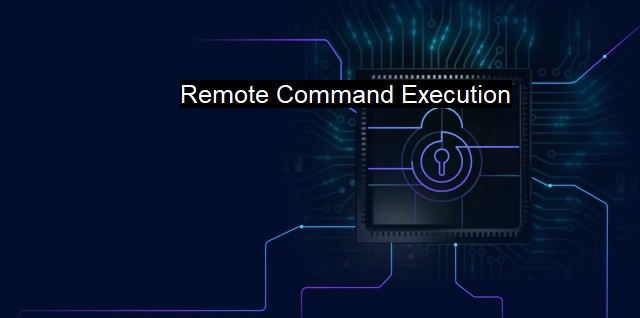What is Remote Command Execution?
Remote Command Execution: A Serious Security Concern in Cybersecurity with DEVASTATING Consequences for Networks and Systems
Remote Command Execution, oftentimes referred to as RCE, is a term used within cybersecurity that defines a process that enables a hacker to access a computer system over a network environment, and control the system actions, remotely executing commands. This technique allows an attacker to perform operations elegantly and covertly, manipulating the target system without generating direct interaction.RCE is especially dangerous due to the vast extent of system control it provides an attacker. The attacker's control could span simple actions such as creating, modifying, or deleting files, to manipulating process operations, accessing sensitive data or, in worst-case scenarios, be escalated to privilege acquisition. For instance, with remote command execution, an attacker could potentially install malicious programs without the victim’s knowledge, making their device a part of a botnet leading to more alarming threats such as massive DDoS attacks or delivering unprecedented malware.
Typically, RCE attacks incorporate three steps. First, the attacker spots an exploitable vulnerability within an application or system, like bugs in the software or inefficiently patched systems. Examples include weaknesses tied to PHP, Java, Python, or CGI scripts, even user input validators which have been poorly constructed can be used as an entry point.
The second step is when the actual exploitation of the vulnerability identified occurs. Using this vulnerability, the attacker delivers a specially constructed payload which, when processed by the vulnerable component, leads it to run specific malicious commands dictated by the attacker, hence triggering remote command execution.
When the malicious commands have been successfully executed, the attacker completes the command and control phase where s/he deliberates ensuing activities for consolidation or exploitation of the compromised system.
Remote Command Execution is one of the major threats omniscient in the internet scenario. Various properties of RCE, such as its capability to remain shielded while controlling the victim's system remotely, make these attacks instrumental in intricate, large-scale attacks where detection and resolution require strenuous efforts.
Recent years have witnessed the rapid development of several counter-measures to mitigate these threats. A crucial player in combating RCE is antivirus software. Porous network security makes it easy for RCE attacks to sneak in; hence, antivirus software comes with inbuilt mechanisms prepared to prevent, detect and remove malware- including that delivered by Remote Command Execution. While antivirus software can block known malicious scripts delivered in an RCE attack, the more sophisticated ones have behavioral detection, firewalls, and Intrusion Prevention Systems (IPS) that alert and deny unauthorized access to the system.
Good programming practices such as applying the principle of least privileges to running processes and services, use of robust input-validation systems and regularly updating and patching all software components significantly reduce RCE vulnerabilities. Regularly assessing the system vulnerabilities can reveal network-wide systematic issues or individual system weak spots that the RCE attackers can exploit.
To summarize Remote Command Execution is a severe threat that enables the attacker to run arbitrary commands on a victim's system. These attacks follow an exploitation, command execution, and control sequence, after finding a vulnerability within an application or system. Working as an invaluable tool, antivirus software helps mitigate the risks of a Remote Command Execution attack by real-time prevention, detection, and removal of malware. Also, adopting stringent secure configuration principles limit the risk that these attacks pose to secure and robust system operation. Modern-day cybersecurity practices continuously aim to enhance these protective, remedial capabilities, thus evolving in the perpetual battle against the persistent threat of Remote Command Execution.

Remote Command Execution FAQs
What is remote command execution?
Remote command execution refers to the ability to execute commands or programs on a remote system or device from a different location. In cybersecurity, attackers often use remote command execution as a tactic to gain unauthorized access to systems and networks. On the other hand, legitimate users can also use remote command execution for various purposes such as managing and troubleshooting multiple devices at different locations.How does remote command execution relate to antivirus?
Remote command execution can be used by antivirus programs to remotely scan and detect malware on different systems and devices. This helps antivirus programs to detect and remove threats from a network of devices even if they are physically located in different places.What are the risks associated with remote command execution?
Remote command execution can pose several security risks, such as unauthorized access, data theft, and system compromise. Attackers can use remote commands to exploit vulnerabilities in systems, steal sensitive data, or take control of devices for malicious purposes.What are the best practices for using remote command execution in cybersecurity?
To mitigate the risks associated with remote command execution, it is essential to follow some best practices such as using strong authentication, encrypting network traffic, limiting access to authorized users, monitoring and logging remote commands, and keeping systems and devices up-to-date with the latest security patches and updates. Additionally, it is important to use trusted and reputable remote command execution tools that offer robust security features and compliance with industry standards.| | A | | | B | | | C | | | D | | | E | | | F | | | G | | | H | | | I | | | J | | | K | | | L | | | M | |
| | N | | | O | | | P | | | Q | | | R | | | S | | | T | | | U | | | V | | | W | | | X | | | Y | | | Z | |
| | 1 | | | 2 | | | 3 | | | 4 | | | 7 | | | 8 | | |||||||